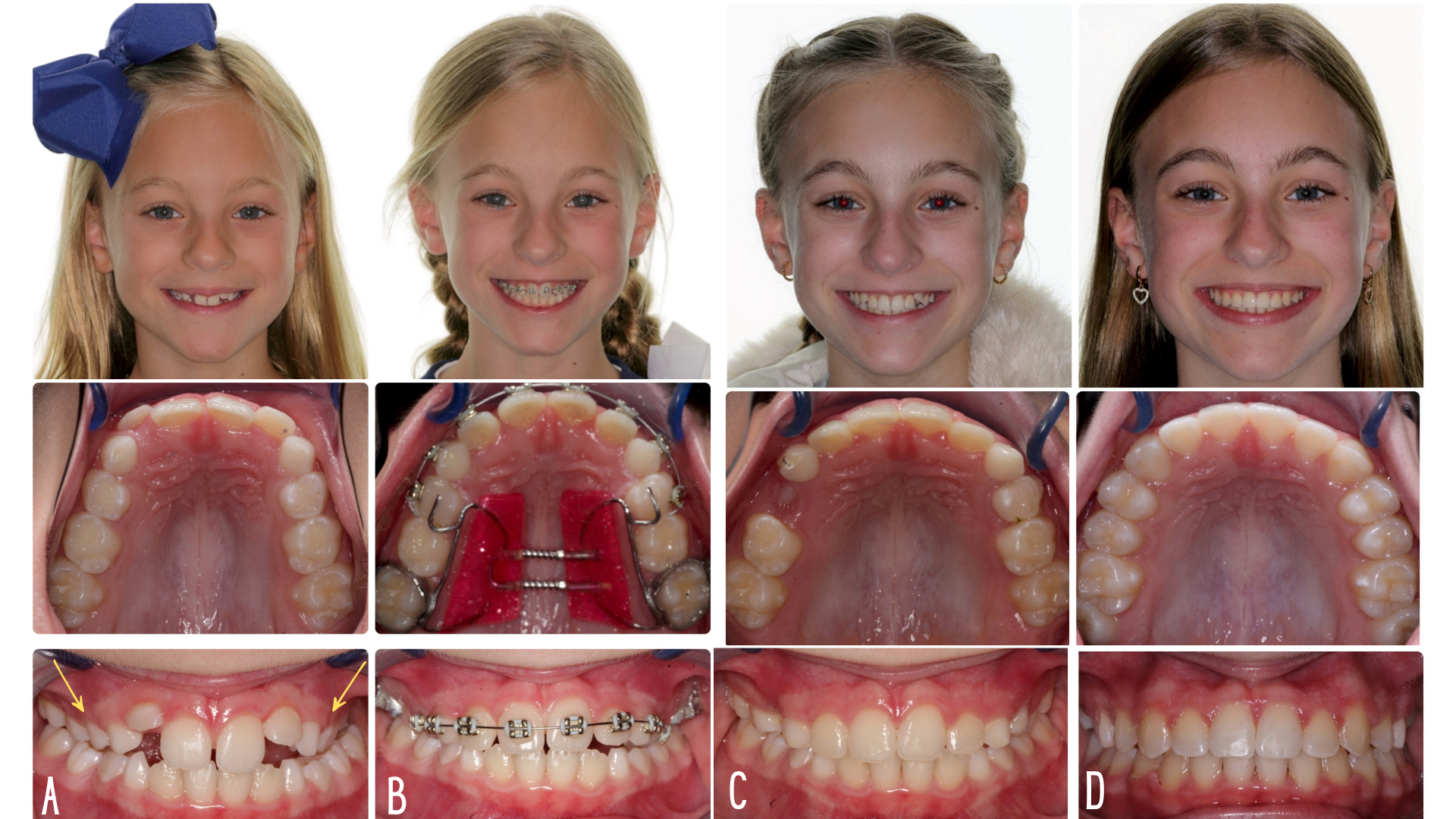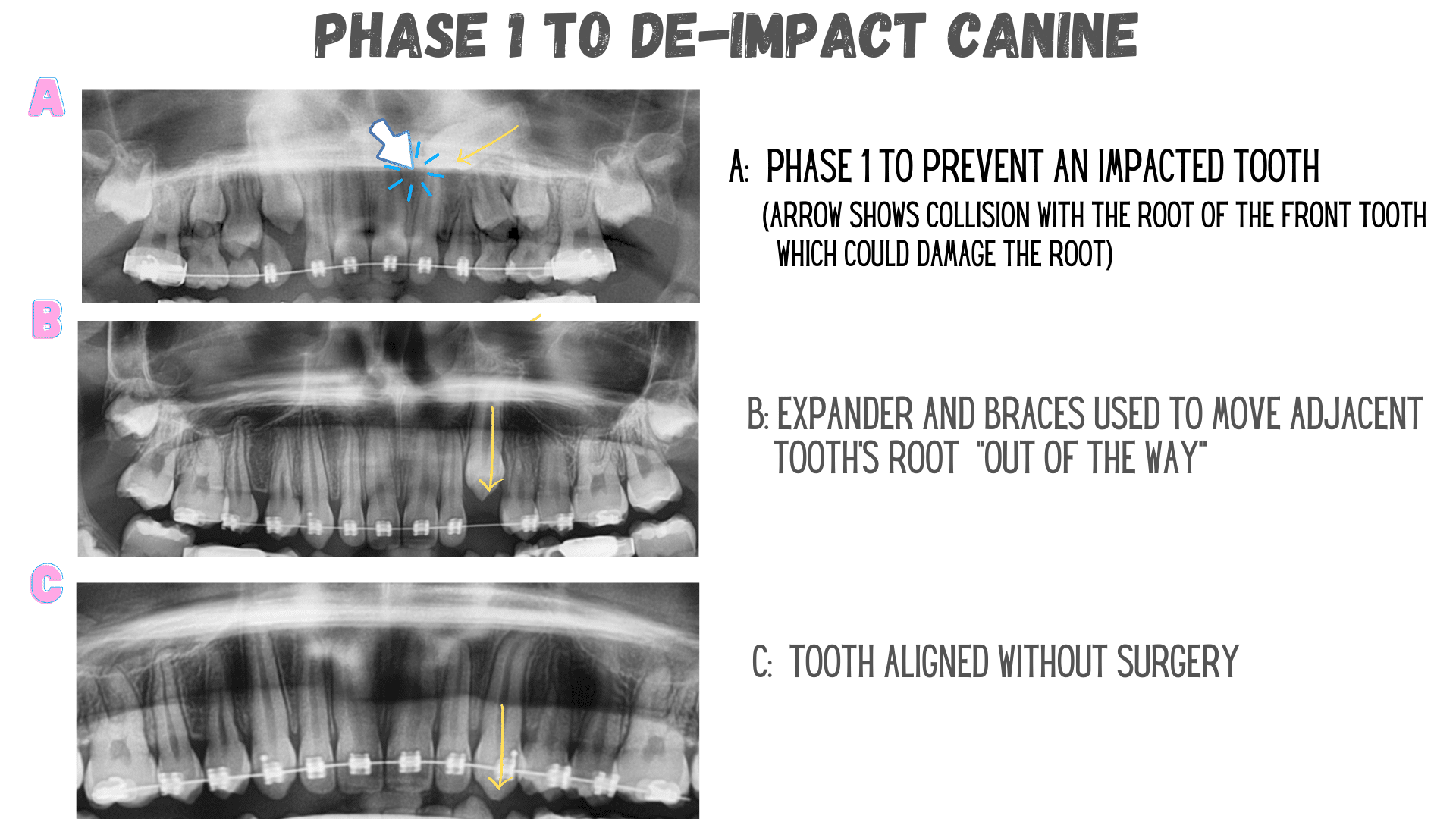Two-Phase Orthodontic Treatment: Giving Kids a Healthy Start
Two-phase orthodontic treatment is a proactive approach used by our kids orthodontist to guide proper jaw development and create room for permanent teeth before all of them have erupted. This process can help avoid extractions, prevent future complications, and create beautiful, long-lasting results.

how does 2 phase orthodontic treatment work?
Below is a typical 2-phase orthodontic treatment progression in our office:

A. Pre-Treatment: Arrows Reveal a Bilateral Skeletal Cross Bite, Narrow Smile, Crowding
B. Phase I treatment: Palate Expander (7 Months) and Upper Braces (12 Months)
C. After Phase I Completion
D. After Phase II Completion (14 months of braces OR Invisalign)
What Is Two-Phase Orthodontic Treatment?
Two-phase orthodontics is a complete treatment plan made up of two coordinated stages: Phase 1 (early interceptive treatment) and Phase 2 (comprehensive alignment). While it’s called “two-phase treatment,” both phases work together as part of one full approach to create the best, most stable long-term result.
Phase 1 typically begins between the ages of 6 and 10 and focuses on guiding jaw growth and correcting issues early before all adult teeth come in. This early intervention can prevent more serious problems later on.
Phase 2 usually happens during the teen years, once all permanent teeth have erupted. It completes the process by aligning teeth and fine-tuning the bite.
By addressing issues in two phases, this approach can help:
- Avoid tooth extractions or impacted teeth
- Prevent the need for jaw surgery
- Improve a child’s self-esteem
- Reduce the risk of gum recession
- Support healthier breathing and airway development
Getting braces is not only about tooth alignment and your smile! Phase 1 Treatment is designed to align the face, the profile, the bite, and the patient’s airway. Aligning the jaws into the correct position results in a better and more stable outcome for esthetics and function.

Does My Child Need Phase I Orthodontics?
Orthodontic treatment is not only about teeth. Healthy and attractive faces work as a balanced system. This “system” involves the jaws, joints, teeth, gums, lips, and tongue. Each part of the system influences the others. The way we breathe, speak, and chew impacts skeletal growth and facial development. Unhealthy growth patterns in a young child can lead to a breakdown of this system early on and cause significant issues later in life.
The American Association of Orthodontists recommends age 7 for your child’s first orthodontic exam. Why so young? Because we are dealing with growth, and many orthodontic problems worsen over time. They are often best addressed with the assistance of growth. A board-certified kids orthodontist can evaluate if there’s an unhealthy growth pattern or improper breathing habits and oral myofunctional disorders that may be contributing to poorly developing jaws. Identifying these concerns early allows for proper correction before more complex treatment is needed later.
At your child’s visit, Dr. DiGiovanni, recognized as one of the best kids’ orthodontists in the area, will assess whether treatment is needed and determine the ideal time to begin. As a top-rated kids’ orthodontist near me for many families in Laguna Beach and Newport Beach, Dr. DiGiovanni provides thoughtful, individualized care.

Why Parents Trust Dr. DiGiovanni
As a top 1% Invisalign provider in North America and a board-certified orthodontist, Dr. John DiGiovanni is one of the most trusted experts in kids orthodontics. He has treated thousands of patients using both traditional braces and clear aligners and is also a clinical instructor at the USC Dental School, where he trains future orthodontists in clear aligner therapy and facial growth.
If you’re searching for the best kids orthodontist near me, Dr. DiGiovanni’s expertise, compassionate care, and proven track record set him apart. With two convenient locations in Laguna Beach and Newport Beach, he’s the go-to kids orthodontist in the area.
Results That Speak for Themselves
We’ve helped countless kids and teens achieve healthier bites, wider smiles, and stronger facial balance with our early orthodontic care. Below are real results from real patients who have undergone phase 1 and phase 2 orthodontics.












FAQ
When Does Dr. DiGiovanni Prescribe 2 Phases of Treatment?
Dr. DiGiovanni prescribes two-phase orthodontic treatment when early intervention can significantly improve the outcome and stability of the treatment. This approach is often used to address developing problems that, if left untreated, could lead to more severe issues as more teeth erupt and facial growth transpires. During your child’s initial exam, Dr. DiGiovanni will determine if two-phase treatment is necessary and the best time to start.
Can My Child Choose Invisalign for Phase 1 Treatment?
Yes, in some cases. About 5% of our phase 1 treatments use Invisalign. This depends on your child’s case and their ability to wear aligners consistently. Invisalign can be used for arch development, habit correction, and space management.
How Do I Know If My Child Needs Two-Phase Orthodontics?
If your child has issues like crowding, underbites, crossbites, thumb sucking, or jaw growth concerns, a consultation will help determine if early treatment is necessary.
What Are the Benefits of Starting Early With a Kids Orthodontist?
Early treatment can guide proper growth, reduce the need for extractions or surgery, improve breathing, and boost your child’s confidence.
Does Early Treatment Always Mean Braces?
Not always. Some treatments use expanders or Invisalign instead of braces, depending on the child’s needs.



